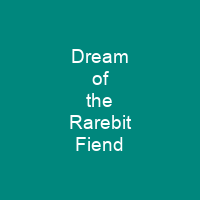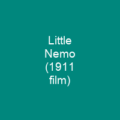Dream of the Rarebit Fiend: A Journey Through Winsor McCay’s Nightmares
Imagine stepping into a world where nightmares come to life, and every dream is a window into the darkest corners of the human psyche. That’s exactly what Winsor McCay created with his iconic comic strip Dream of the Rarebit Fiend. Begun on September 10, 1904, this newspaper gem has captivated readers for over a century, offering a unique blend of social commentary and psychological insight.
The Birth of an Iconic Strip
McCay’s Dream of the Rarebit Fiend was his second successful comic strip after Little Sammy Sneeze. Unlike its predecessor, which aimed at a younger audience with its whimsical and humorous content, this strip delved into more mature themes. The name “Rarebit” comes from Welsh rarebit, a dish that McCay himself enjoyed, but the theme of the strip was far from comforting.
Exploring Dreams Through Art
The artwork in Dream of the Rarebit Fiend is a marvel. With minimal backgrounds and static perspectives, the focus shifts to the content rather than the visuals. McCay’s characters often find themselves in fixed positions, their expressions capturing the essence of their inner turmoil. The strip’s content played a bigger role than its illustrations, focusing on adult-oriented subjects such as social embarrassment and fear of dying or going insane.
Themes and Motifs
The recurring motifs in Dream of the Rarebit Fiend include small, shy men dominated by their taller or fatter wives, gigantism with characters overwhelmed by rapidly growing elements, and themes of insanity. These motifs reflect McCay’s own experiences and his exploration of dreams through his earlier works like Daydreams and It Was Only a Dream.
A Personal Reflection
Marrying in 1891, McCay’s personal life was far from perfect. His wife stood as tall as he did, which may have inspired the recurring theme of small men dominated by larger figures. The couple depicted in the strip often struggled with hypocrisy, jealousy, and misunderstanding, mirroring their own relationship.
Artistic Evolution
Much like his other works, Dream of the Rarebit Fiend was a reflection of McCay’s evolving artistic style. His lettering was awkward and could be illegible, particularly in reproductions. He rarely referred to himself as “Silas,” a pseudonym inspired by a neighborhood garbage cart driver who dominated his life.
Legacy and Adaptations
Dream of the Rarebit Fiend was McCay’s longest-running comic strip, with over 300 episodes. It first appeared in the New York Herald after his successful Little Sammy Sneeze. The strip ran from 1900 to 1911, with revivals in 1913 under different titles and a final run from 1923 to 1925. McCay’s work was popular enough to get him hired by William Randolph Hearst’s newspapers, but he was later asked to give up comic strips for editorial cartooning.
Artistic Influences
The strip drew inspiration from a wide array of literary and artistic sources, including Edward Lear, Gelett Burgess, Lewis Carroll, H.G. Wells, L. Frank Baum, J.M. Barrie, Carlo Collodi, Arthur Conan Doyle, Henryk Sienkiewicz, Robert Louis Stevenson, and Mark Twain.
From Comic Strip to Film
Dream of the Rarebit Fiend was adapted into films by Edwin S. Porter in 1906 and later by McCay himself. His four hand-drawn animated films based on his Rarebit Fiend series, including How a Mosquito Operates, Bug Vaudeville, The Pet, and The Flying House, showcase the evolution of animation techniques during that era. These films not only highlight McCay’s artistic genius but also his ability to push the boundaries of what was possible in animation.
Conclusion: A Lasting Legacy
Dream of the Rarebit Fiend remains a testament to Winsor McCay’s visionary approach to storytelling. Through its exploration of dreams and nightmares, it continues to resonate with audiences today, offering a glimpse into the darker aspects of human nature. As we continue to explore the depths of our own subconscious, Dream of the Rarebit Fiend stands as a timeless reminder that sometimes, the most profound insights come from the darkest corners of our minds.

You want to know more about Dream of the Rarebit Fiend?
This page is based on the article Dream of the Rarebit Fiend published in Wikipedia (retrieved on December 4, 2024) and was automatically summarized using artificial intelligence.







